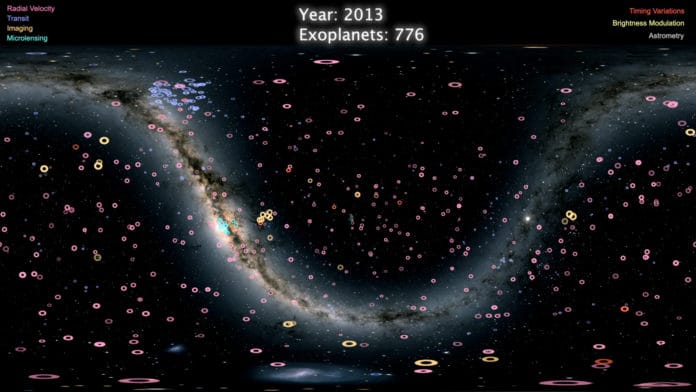Exoplanets are a subject of interest for astronomers since they orbit various stars, but because they can potentially harbor life. A few exoplanets found have been seen to have climate, for example, hot Jupiters and hot Neptunes, described by close orbiting around their star and in this manner having warmed and broadened air.
Be that as it may, astronomers have logged thousands of exoplanets since astronomers affirmed the presence of the first exoplanet in October 1991. NASA confirmed the 4,000th exoplanet and is now celebrating the discovery with a fantastic map of all the exoplanets found to date.
Recently NASA has released a dazzling video map of all the exoplanets it has ever spotted, including those from dedicated world-hunting crafts Kepler and TESS.
The artist Matt Russo created the animation and scored by the musician Andrew Santaguida, who both works with a science-art outreach project called System Sound. The short film was published on YouTube on Sunday and described on Wednesday by NASA’s Astronomy Picture of the Day (APOD) site.
Much of the exploratory work was performed by the now-retired Kepler Space Telescope, a retired space telescope launched by NASA to discover Earth-size planets orbiting other stars. Launched in 2009, the telescope has spent almost a decade orbiting the sun while peering into deep space to uncover some of its many mysteries.
Retired in 208, the Kepler telescope documented 61 supernovae and confirmed the existence of thousands of planets, collecting 678GB worth of scientific data along the way in its lifetime.
Now, the search for more exoplanets has recently been taken up by TESS (Transiting Exoplanet Survey Satellite). TESS is exploring a far larger area as part of a more ambitious mission that’s expected to uncover a staggering 20,000 exoplanets in just a couple of years.
The featured video highlights these exoplanets in sound and light, starting chronologically from the first confirmed detection in 1992. The entire night sky is first shown compressed with the central band of our Milky Way Galaxy making a giant U.
Exoplanets detected by slight jiggles in their parents-star’s colors (radial velocity) appear in pink, while those identified by small dips in their parent star’s brightness (transit) are shown in purple. Further, those exoplanets imaged directly appear in orange, while those detected by gravitationally magnifying the light of a background star (microlensing) are shown in green.
The faster a planet orbits its parent star, the higher the accompanying tone played.
